Galatea was the statue Pygmalion, her creator, fell in love with.Impressed by the sculptor's love for the statue, Afrodita
gave life to Galatea.This are my viws of Galatea, A watercolor painting of Afrodita giving life to galatea and a
pencil drawing of galatea
Demeter and her parthenogenetic daughter(Kore or Persephone), the two goddesses of agriculture
Hades took Kore to the underworld to become his wife Persephone, the queen of the underworld
Psyche.
In Greek mythology, DanaŽ was a daughter of King Acrisius of Argos and Eurydice (no relation to
Orpheus' Eurydice). She was the mother of Perseus by Zeus. She was sometimes credited with founding the city of Ardea in Latium.
Disappointed by his lack of male heirs, Acrisius asked an oracle if this would change. The oracle told him to go to the
Earth's end where he would be killed by his daughter's child. She was childless and, meaning to keep her so, he shut her up
in a bronze tower or cave. But Zeus came to her in the form of rain or a shower of gold, and impregnated her. Soon after,
their child Perseus was born.
None too happy, but unwilling to provoke the wrath of the gods by killing his offspring, Acrisius cast the two into the
sea in a wooden chest. The sea was calmed by Poseidon at the request of Zeus and the pair survived. They washed ashore on
the island of Seriphos, where they were taken in by Dictys, the brother of King Polydectes, who raised the boy to manhood.
Later, after Perseus killed Medusa and rescued Andromeda, the oracle's prophecy came true.
He started for Argos, but learning of the prophecy instead went to Larissa, where athletic games were being held. By chance
Acrisius was there, and Perseus accidentally struck him with his javelin (or discus), fulfilling the prophecy. Too shamed
to return to Argos he then gave the kingdom to Megapenthes, son of Proetus (Acrisius' brother) and took over his kingdom of
Tiryns, also founding Mycenae and Midea there.
Korinna
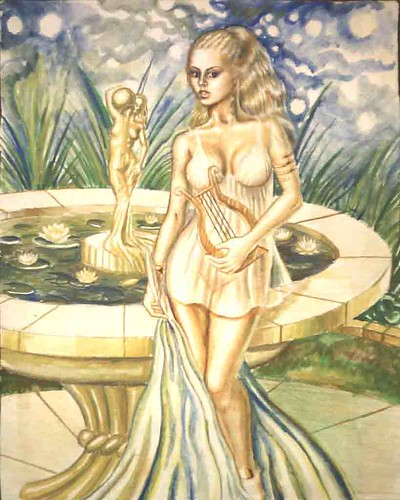
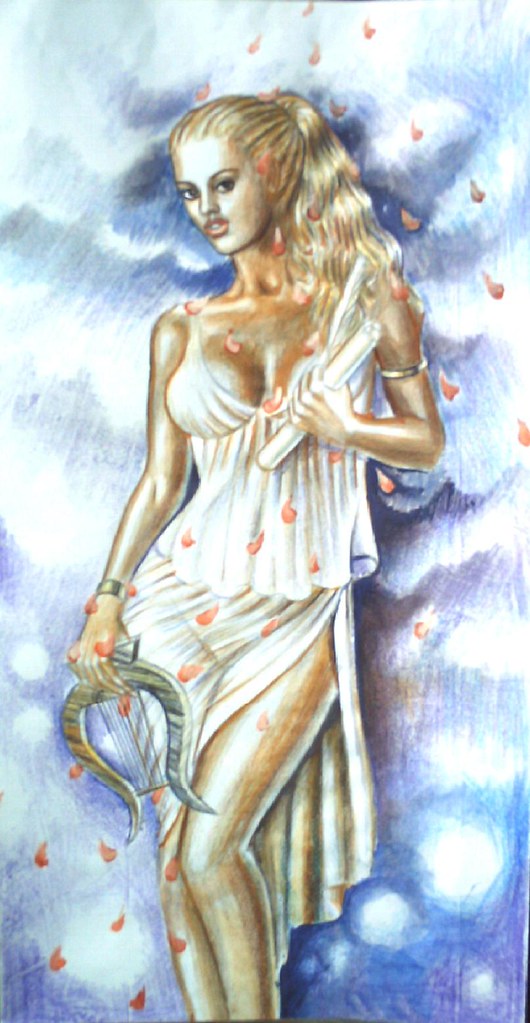
Like Sappho, Korinna from Tanagra was one of the greatest poets in the ancient Greece.We don't know when she was born but
she lived around 500 b.c.Her works treated subjects related to greek mythology and the link betweent myths and real life.This
is my painting of Korinna
Sappho
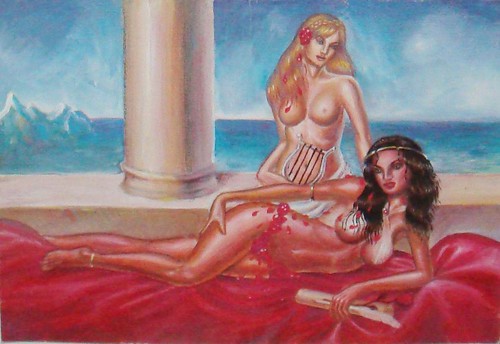
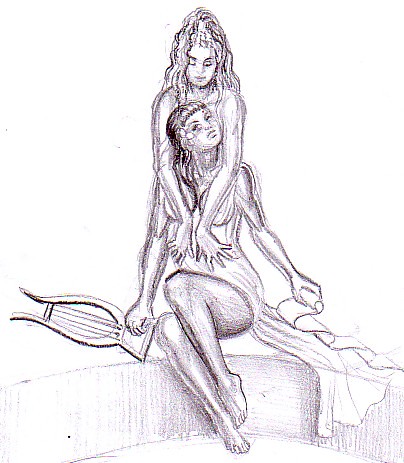
Sappho was born around 615 B.C. on the N.E. Aegean island of Lesbos in the Pre-classical Greek period at the very foundation
of the later Greek Democracy. This was an exciting new time, and Sappho was involved with all the changes that occurred. For
example, the Greek alphabet had just been invented, coin money was minted for the first time, the political system had changed
radically, and the arts were vigorously renewed. Sappho was greatly loved throughout antiquity both for her personal qualities
and creativity. She was widely acclaimed for the astonishing beauty and originality of her lyric poetry which she brilliantly
perfected. Poetry in her day was usually accompanied by music and dance. Sappho was so accomplished at composing in all three
modes, that she acquired the reputation for being the Divine Inspiration of the Muses. She was held in high esteem and copied
even 500 years after her death. However, for the past two thousand years, her work has been fragmented and distorted. Absurd
myths have been attached to her name by the patriarchy
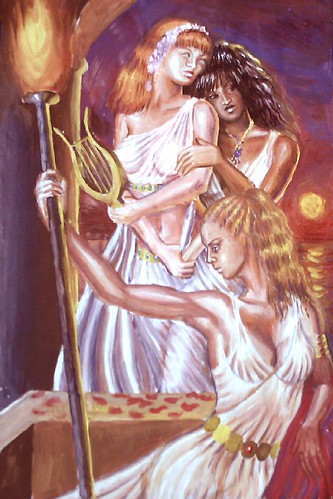
Korinna, Erinna and Sappho, the greatest female poets in the ancient Greece
Sappho, Erinna and two of the young maidens in the temple of Aphrodite celebrating the goddess
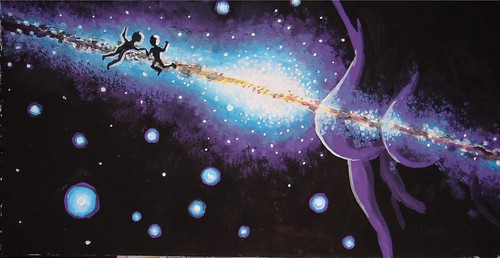
The legend of the milky way
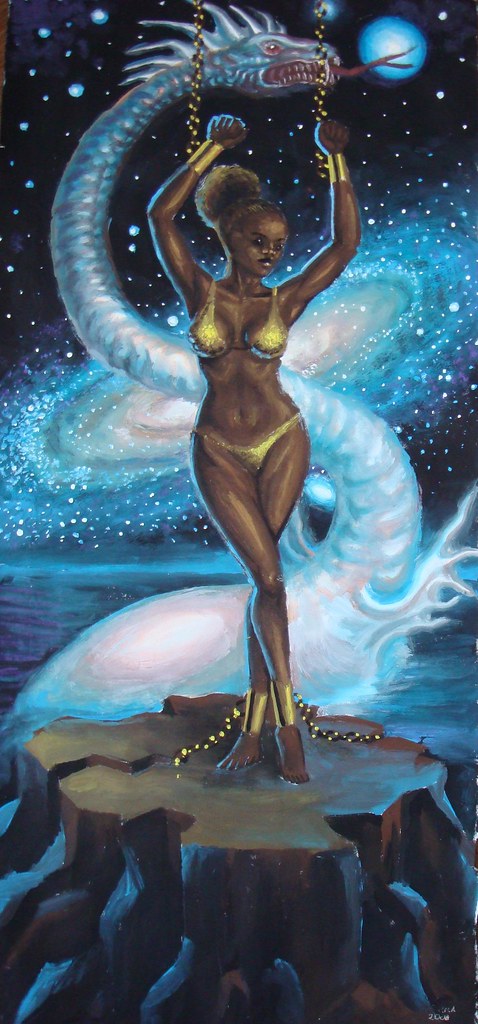
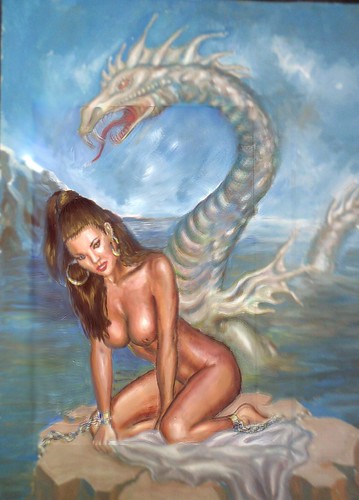
In Greek mythology, Andromeda ("ruler of men") was the daughter of Cepheus and Cassiopeia, king
and queen of Aethiopia.
Cassiopeia, having boasted herself equal in beauty to the Nereids, drew down the vengeance of Poseidon, who sent
an inundation on the land and a sea-monster, which destroyed man and beast. The oracle of Ammon announced that no relief would
be found until the king exposed his daughter Andromeda to the monster, so she was fastened to a rock on the shore.
Perseus, returning from having slain the Gorgon, found Andromeda, slew the monster, set her free, and married her in spite
of Phineus, to whom she had before been promised. At the wedding a quarrel took place between the rivals, and Phineus was
turned to stone by the sight of the Gorgon's head (Ovid, Metamorphoses v. 1).
Andromeda followed her husband to Tiryns in Argos, and became the ancestress of the family of the Perseidae through Perseus'
and Andromeda's son, Perses. Perseus and Andromeda had six sons (Perseides): Perses, Alcaeus, Heleus, Mestor, Sthenelus, and
Electryon, and one daughter, Gorgophone. Their descendants ruled Mycenae from Electryon down to Eurystheus, after whom Atreus
got the kingdom, and include the great hero Heracles. According to this mythology, Perses is the ancestor of the Persians.
After her death she was placed by Athena amongst the constellations in the northern sky, near Perseus and Cassiopeia. Sophocles
and Euripides (and in more modern times Corneille) made the story the subject of tragedies. The tale is represented in numerous
ancient works of art.
Andromeda is represented in the northern sky by the constellation Andromeda which contains the Andromeda Galaxy.
.
The Daughters of Minyas
Bacchus was the god of wine and of the special form of inspiration that wine brings.
His divinity was eventually to be acknowledged across the ancient world, but that did not happen without opposition. The last
of the myths of Bacchus belong to the period that followed his ascent to mount Olympos, and they tell how it came about that
his divine power was asserted and his opponents were finally defeated.
Strangely, the opposition to Bacchus was at its strongest in the very region of Greece where he was conceived.
There is a small, ancient city in Boiotia, Orchomenos, forty miles from Thebes. Orchomenos, its founder, was
the son of Zeus and Danae (one of Semele's predecessors). His son Minyas was now king of Orchomenos, and he had three daughters,
Leukippe, Arsippe and Alkithoe.
They were good, hard-working, home-loving girls. They loved their husbands, says Aelian, who gives an outline
of their story in his Miscellany. They loved their spinning, according to Ovid, and they saw no reason to interrupt their
quiet pleasures because the priest of Bacchus had announced a festival for the new god. What was more, they saw no reason
to give their servants a holiday.
Elsewhere in Orchomenos - and elsewhere in Boiotia - noblewomen and slaves side by side wrapped fawnskins
around their shoulders and unfastened the ribbons that usually tied their hair. They put on wreaths of vine and ivy, and each
carried a thyrsos, as they set out towards the mountains at nightfall to enact the traditional ritual that young Bacchus and
his Mainads had established. The lines of ever-moving torches grew longer and reached higher towards the sky. The household
of Minyas and his daughters worked as hard as ever. Can it be that they were worshippers not of Bacchus but of Hera, who favours
married love and dutiful households? They spun and wove and made sure that their servants worked alongside them.
One unexpected detail is provided by Antoninus Liberalis in a collection of mythical tales called Metamorphoses;
he drew on the work of a local Boiotian poetess, Corinna of Tanagra, according to whom Bacchus himself visited the recalcitrant
household of Minyas and for this purpose temporarily adopted the shape and the persuasive tones of a young girl.
'All the women of Orchomenos are on their way to the mountains,' she said. 'Will you not join them in the
worship of Bacchus?'
They seemed not to be listening.
'This new god is powerful,' she continued modestly, 'and he has much to offer to us mortals.'
They were not interested.
'It is said that he becomes impatient with those who reject him, and uses his power to punish such people.'
They changed the subject.
Bacchus found that he was becoming impatient. He turned into a lion cub, and that new shape, though it left
him unable to use human speech for persuasion, did at least monopolise the attention of the household of Minyas. The lion
cub glanced for a moment at the beams that formed the frame of the loom at which some of the women were working. In response
to that glance, milk and honey began to drip from the ends of the beams. Then he turned into a leopard, and at the same moment
the flow of milk became a river of wine. Then he became a bull. And during these transformations the noise of unseen drums,
cymbals and flutes was heard through the house. The sacred scent of myrrh and saffron filled the air. The half-finished tapestry
on the loom developed leaves and tendrils and turned itself into a flourishing vine.
The daughters of Minyas were never truly conscious of the powers of the god that they had scorned. Until this
moment they had been composedly scornful of the new religion and its demands. Now, as the house was transformed around them,
Bacchus entered their minds, as gods can, and their terror and confusion led them beyond all understanding.
They knew at once that a sacrifice must be made to lessen his anger. That was almost all that they knew ...
but no: they remembered having had a way of choosing when some unwelcome task had to be allotted to one of the three. They
threw three pebbles, each of a different colour, into an earthenware jug, and a servant reached in blindly to bring out one
of them. It was Leukippe's. She must provide the sacrifice. So Leukippe called for her son, Hippasos, and when he came she
seized hold of him and held him down. Then, helped by her two sisters, she tore him to pieces. As was proper at sacrifices,
she burned the fat from his body on an altar; the flesh they themselves tasted. At last, with the blood of Hippasos still
running from their lips and spattering all their clothes, the three sisters made their way towards the mountain. The rest
of the womenfolk of Orchomenos were meanwhile returning, but the daughters of Minyas remained there, feeding on ivy leaves,
bindweed and bay.
Eventually Hermes, aware of their apparently endless confusion, ended it by turning them into three creatures
of the air, a real metamorphosis succeeding the false one. Leukippe became a bat, Arsippe a little owl and Alkithoe an eagle
owl. All three of these hate the sunlight, Antoninus Liberalis observes. Ovid, however, says that it was Bacchus himself,
not Hermes, who effected the transformation, and all three became bats. As Ovid tells it, on a certain night so dark that
they could not see what was happening to them, all three of the sisters felt that skinny membranes were growing along their
arms and legs, and they themselves were shrinking. Although they had no feathers they found that they could fly, and that
is what they have done ever since, every night, still continuing their complaints in thin, high-pitched, reedy voices. Appropriately,
since they had been so reluctant to go to the woods and hills with the Mainads, they now do not haunt the woods and wild places,
as birds do, but attics, roofs and barns.
If -- under the influence of Bacchus -- the daughters of Minyas sacrificed Leukippe's baby son Hippasos, tore
his body apart, and tasted his flesh, they were doing things that participants in the mysteries of Bacchus were believed to
do in historic times. Which is why, at one moment in the story of Euripides' Bakchai, when the mother
and sisters of Pentheus return from their Bacchanal with Pentheus's dismembered body, they talk as if they are about to taste
the raw flesh. In all probability participants in some mystery rites really did tear apart animal victims and eat their raw
flesh; the practice is called omophagia, 'eating raw'. Cannibalism -- an accusation that could
grow rather naturally out of observations of omophagia -- is suggested by Livy in his narrative
of the suppression of the Bacchanalia in Italy in 186 BC, in which he alleges killings of participants, whose very bodies were
never afterwards found for burial.
The story of the daughters of Minyas is told by Antoninus Liberalis, Metamorphoses
10, citing Korinna and Nikandros; also by Aelian, Miscellany 3.42; Ovid, Metamorphoses
4.1-415; Plutarch, Greek Questions 38. For the momentary idea of Pentheus's mother and sisters that
they will feast on the flesh that they have killed -- on Pentheus himself, in effect -- see Euripides, Bakchai
1184 with E. R. Dodds's note in his commentary on this passage.
This is my painting of the daughters of Minyas
This is my drawing of Medusa, one of the gorgon sisters
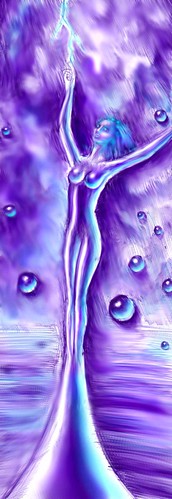
The birth of Afrodita



